Art collector Peregrine Cavendish, Duke of Devonshire (an interview)
The 12th Duke of Devonshire tells about his family art collection and gives some insights on Chatsworth House and the Devonshire Collection’s show at Sotheby’s in New York.
In celebration of Sotheby’s 275th anniversary and to show off its expanded and reimagined New York galleries, the venerable auction house is presenting Treasures from Chatsworth — a rare, public exhibition in the United States of works from the fabled collection of the Duke of Devonshire, held at historic Chatsworth House in the United Kingdom. Offering more than 40 masterworks spanning the past 500 years, the exhibition features Leonardo da Vinci’s extraordinary drawing of Leda and the Swan, striking portraits by Thomas Gainsborough and Lucian Freud, Raffaelle Monti’s magical marble sculpture of A veiled Vestal Virgin and a selection of costumes and ceramics, along with some of the family jewels. Conceptual Fine Arts recently sat down with the 12th Duke of Devonshire at Sotheby’s to discuss the coveted collection and his role in growing and maintaining it.
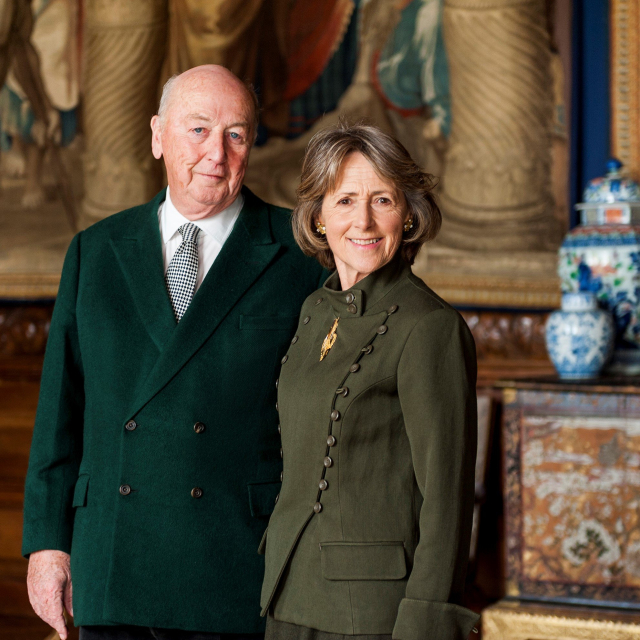
Photo by Simon Broadhead, © Chatsworth House Trust.
On Art Collecting.
What does collecting represent to you?
A few of my family members collected in a knowledgeable way, particularly the second Duke with the Old Master drawings and Lord Burlington with decorative arts and painting and sculpture. It was the sixth Duke who was probably the most acquisitive, even though he had no formal arts education. My father was interested in contemporary art, yet he had a reasonably good knowledge of the whole collection. My mother had a more scattergun approach, in that she was very knowledgeable about some bits and knew very little about others. My wife Amanda and I had no formal arts education, although I did spend a lot of time at school going to exhibitions—thanks to a teacher who took a group of us to museums and galleries almost every weekend one year. And Amanda’s mother was self-taught, but very knowledgeable about contemporary art. So we both came from backgrounds where there was contemporary art, but often things that my parents and her parents’ friends didn’t like, like the Lucien Freud portrait of my mother, which outraged a number of people. That taught us both separately and then together that you shouldn’t worry too much about what other people think, which has continued to influence our collecting. (Duke of Devonshire)
Do you remember the first artwork that you acquired?
We started, like a lot of people do, collecting posters and prints. I think the first thing that I bought, when I was about 15, was a not-very-good reproduction of a Corot in an art shop on the street of my school. I still have it. It’s rather a lovely thing. It’s not worth anything, but I never thought to collect for that reason. I know that some people are very successful at it, but I simply don’t get it. I wish in hindsight that there had been a course in the history of art at school, which I don’t think there was—certainly not at Oxford when I went there. (Duke of Devonshire)
When did your family begin collecting art and design objects? (Here a link to our writing about another important aristocratic art collection, the of Prince of Liechtenstein’s one)
It was right from the start. When Bess of Hardwick built her houses she built very big houses because she was very rich and wanted to show off. If you’re going to build a big house you need to have big stuff inside of it—it was all part of the shop. When the Elizabethan house at Chatsworth was knocked down and the first Duke rebuilt it in the style of the day he wanted to also show off. He covered everything in gold. He didn’t want a hideaway. He wanted people to see how rich and powerful he was and of course he had suitable accoutrements, if you like, inside as well as out. That’s changed, but we can still celebrate those things. Now it’s more about the objects and the architecture and the landscape—particularly the landscape, of those three it’s the most important—than it is about the people. Today we aren’t important, but in their time they were very important politically, and locally as well. It’s kind of gone full circle. We’re very lucky. Although the collection is not intact, the broad brush is intact; and the landscape is very well preserved. It’s sort of one great big bit of land art. (Duke of Devonshire)
How did the family acquire its major collection of Old Masters drawings?
The second Duke was an avid and intellectual collector, and had people looking for him without much competition at the time. He was able to acquire the Flinck collection from under the nose of a French diplomat. That became the core of the drawings collection and then he collected around it. His son added to it a bit. (Duke of Devonshire)
Are these works open for viewing to scholars and artists?
Yes, the collection is open to scholars and artists for research. The drawings are kept in dark cabinets, but we display about twelve at a time; and people do come to see drawings by appointment. We’ve started digitalizing the archive so that there’s less pressure of the actual objects and less pressure on our team to have to attend to people doing research. We hope to get everything online at some point. (Duke of Devonshire)
Why have you sometimes sold pieces from this drawings collection?
Because we needed the money. It’s been for various purposes, but mainly to look after Chatsworth. We just spent more than $40 million restoring it and part of that was raised by selling a Raphael drawing for $48 million at Sotheby’s in 2012. There was another big Christies sale in 1984, which was partly for Chatsworth and partly for other properties. Big houses cost a lot of money to maintain. From an art history point of view, the biggest sale was in the early 1950s when we had to pay an 80% inheritance tax on everything. The eight best works went to the British government, along with Hardwick House and its contents. It would be great to still have some of those eight objects, but they are in very good hands, and selling Hardwick—or giving it away, however you see it—was a brilliant thing to do. It was my father’s idea. He didn’t want two huge houses. They’re too expensive, and you can’t spend time in them. My family used to have about six or seven houses and they went round and round to them. I wouldn’t like it. We only need one place. (Duke of Devonshire)
We have sold things, but there have been good replacements, such as the Lucien Freud’s—even if most of the things that we bought are only worth about a quarter of what we paid for them. That’s the way the art market works, but there are one or two things, even if they aren’t valuable, that I think will be of interest to generations to come. We can never judge it. We’re all prejudice because we bought them and think they are wonderful, but other people may think differently.
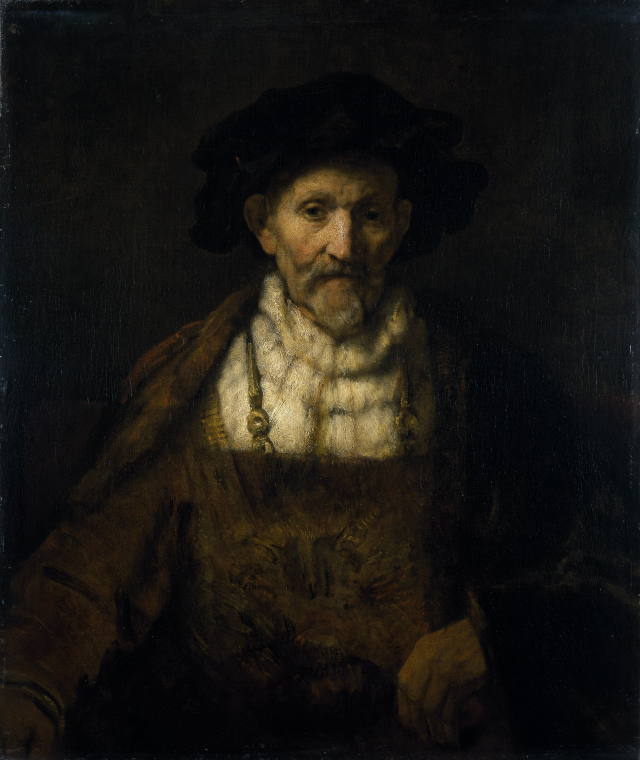
Rembrandt van Rijn, Portrait of an Old Man, 1651. © Chatsworth House Trust.
Old masters in the Devonshire Collection.
You also have a number of Old Masters paintings in the collection, including works by Rembrandt van Rijn, Anthony van Dyck and Jan van der Vaardt. One of the most popular pieces at Chatsworth is Van der Vaardt’s Trompe l’Oeil Violin, which depicts a realistic violin that looks like it’s hanging on the door of the music room. What role does the precise presentation of this work, which is behind another closed door, play in the viewer’s response to it? (Here the link to our writing about France and Holland’s recent acquisition of the Soolmans Coppit double portrait by Rembrandt)
I think it plays a considerable amount, particularly in the way visitors view that room. They first see it from a distance. There’s an actual brass nob with a blue ribbon round it that sticks out just above the violin, which adds the the illusion of the violin being three-dimensional. It’s a very memorable artwork because when you are caught out by something you remember it. People see it as an actual violin, but then they see that it’s only a painting of a violin it sticks in their thoughts. I think that the way it’s placed—to answer your question—is very important. Raffaelle Monti’s A veiled Vestal Virgin, which defies that fact that it’s carved from one piece of marble, and the Digital portrait of Lady Burlington by Michael Craig Martin, that randomly changes colors, are two other artworks that are particularly memorable. They also catch you out. With the veiled vestal virgin, people think that can’t be one piece of stone, but it is. There’s a contemporary artist named Barry X. Ball who does something similar. I love his work. The first time I saw it—years ago now—it innocently struck me.
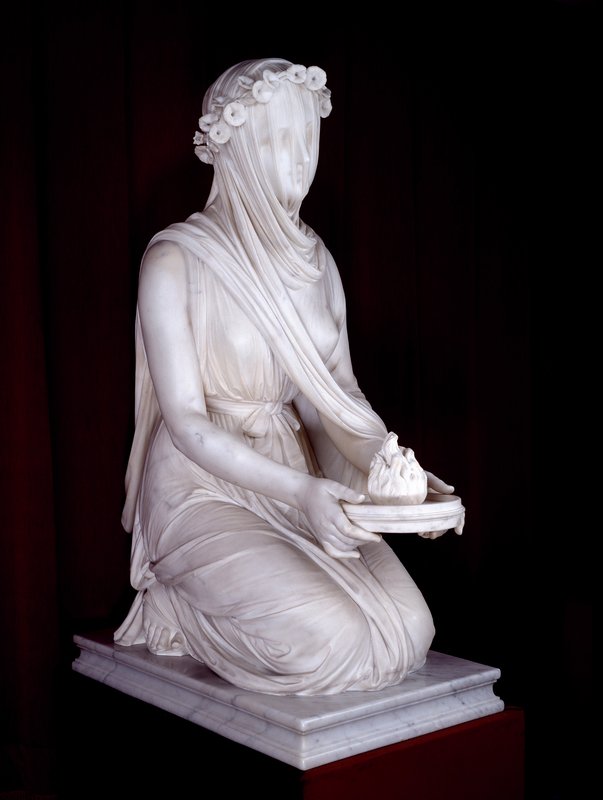
Raffaele Monti, the Veiled Vestal, 1846 © Devonshire Collection. Reproduced by permission of Chatsworth Settlement Trustees.
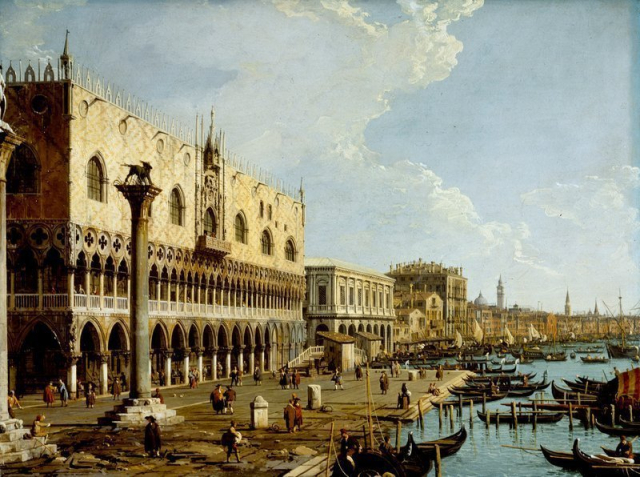
Canaletto, Venice: A View of The Doge’s Palace and The Riva Degli Schiavoni from The Piazzetta. © Devonshire Collection. Reproduced by permission of Chatsworth Settlement Trustees.
There are also magnificent works by such Italian masters as Leonardo da Vinci, Canaletto and Antonio Canova. Why have you lent the Trust’s two precious Canaletto paintings of Venice and Da Vinci’s marvellous drawing of Leda and the Swan to the exhibition, but not Canova’s life-size marble sculpture The Sleeping Endymion?
Endymion would have been a very big piece to ship and we have no idea whether there are any cracks in it internally. It would be really scary to move it. One day we’ll x-ray it. It would have been lovely to have it in the exhibition, but at least we have the other, small transportable things. And we have the Vestal Virgin, which is lovely and has that bit of a trick with the veil. The Sleeping Endymion is Canova at his best. He only finished it a year and a half before he died. It’s as good as it gets. It’s not one of his big grand pieces, but it’s beautiful. I would have loved to have brought it, but we had to be practical.
How did it come into the collection?
It was commissioned by the sixth Duke, who was born in 1790 and inherited in 1811, when he was 21. His father had married his mistress after the sixth Duke’s mother died. He didn’t get on very well with his stepmother, but after her husband died she went to live in Rome. She got to know influential people there and through the Vatican’s Cardinal Ercole Consalvi she met a number of artists. We have a bust of Consalvi by Canova in the Sculpture Gallery at Chatsworth. By then the sixth Duke, who was a very good man, had made peace with his stepmother and went to visit her in Rome, where he fell in love with Roman sculpture. (Duke of Devonshire)
In his diary he said that he had hoped to buy antique sculptures, but all of the good ones were gone. Instead, he was attracted to Canova, who was the star of the day. The Duke got to know him and said I’d like you to do something for me. He gave him a big sum of money without telling him what he wanted and took the risk—and this is what happened. It was a happy ending. He also bought a larger-than-life head of Napoleon and a full scale sculpture of Napoleon’s mother, both by Canova. That was only seven or eight years after the Battle of Waterloo, which makes it so odd. Napoleon was very popular in England, even though he was the national enemy.
Was Thomas Gainborough’s stunning portrait of Duchess Georgiana also a commission?
No, that painting didn’t come to Chatsworth until more recent times. I don’t know who commissioned it, but it was originally a full-length portrait. A person who owned it at some point didn’t have room for it so it was in half, which happened a lot in the 18th century. Then it was sold at Christie’s for £10,000, which was the highest price paid for a work of art at the time. It was bought by Thomas Agnew & Sons and put in their window, where it was stolen by a man named Adam Worth. He kept it for 25 years while trying to sell it, but the Pinkerton Agency caught him and found the painting in the bottom of a trunk. It was returned to Agnew’s and J.P. Morgan bought it. It remained in his family’s collection until 1994, when my father bought it for the Chatsworth House Trust. In a sense it didn’t come home because it had never been home, but it’s the right place for it. It’s an amazing picture. My mother originally didn’t believe it was Georgiana because she didn’t have such a fat face, but she was eventually persuaded that it was her.
The Da Vinci drawing also has an interesting story, does it not?
Yes, in 1938 there was going to be an exhibition of Da Vinci’s work in Milan. My grandfather was asked if he would lend the drawing and he said no because of his fear that war was coming. But then he found that the king had said that he would lend his collection of Da Vinci’s works to the exhibition, so he felt obliged to send ours, too. The war came and the drawings were moved the Castlel Sant’Angelo in Rome for safe keeping. When the drawing was finally returned in 1948 there was a little bit of damage: a little white dot on the tummy of Leda.
I’ve been told that people later advised my father to get it restored, but that he thought it was a badge of courage for his father to having sent it. Since it had made its way back home he said that he didn’t want to get it restored because he wanted to remind himself of the story, which is rather nice. It adds to the layers of happenstance. (Here a link to our story about Rodolfo Siviero, an Italian agent who saved many artworks during the second World War. He was British intelligence’s point of reference in Florence).
The Duke of Devonshire and Lucian Freud.
How did your parents come to commission Lucian Freud to paint their portraits and the portraits of other family members?
That happened very soon after the war. My father had two younger sisters and they got to know Freud. They both sat for him, but not on the condition of purchasing the paintings, even though they would have cost very little. My father was introduced to Freud and got to know him. They had a close, shared interest in gambling, which was illegal until 1961. They used to go to the horse races together. Freud liked gambling a lot when he was poor. My father visited Freud’s studio and saw the pictures of his sisters and he bought them.
He commissioned Freud to paint my mother, and then his own mother. Then in 1971 he commissioned Freud to paint a portrait of himself. He bought one or two more pictures and the House Trust bought Skewbald Mare, which is a painting of the back end of a horse. My mother had first seen the painting in his studio and always admired it. And I bought some etchings from Freud. He loved cash. I sat for him during a summer holiday and he did an oil sketch of me as a sort of present for my father.
My parents happened to get on very well with him. It was obviously very gratifying for my father when Freud became recognised, because he had always liked the work. Freud was definitely underappreciated when they first met.
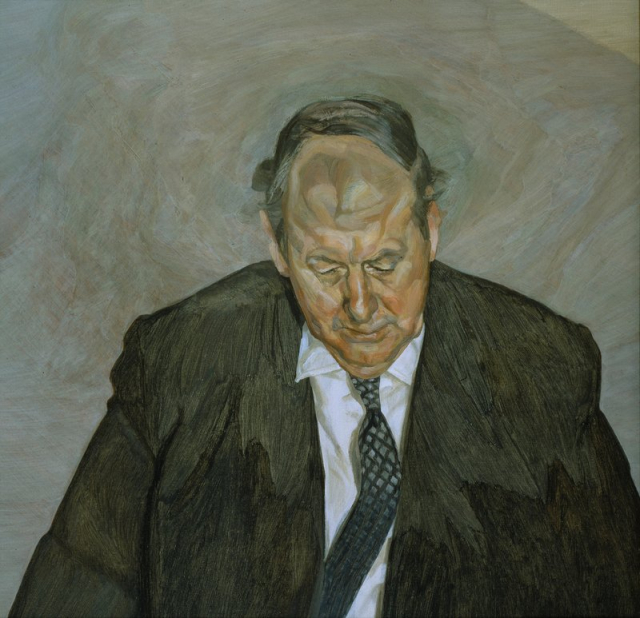
Lucian Freud, Portrait of a man Andrew Cavendish, 11th Duke of Devonshire. © Devonshire Collection. Reproduced by permission of Chatsworth Settlement Trustees.
Woman in White Shirt has the most amazing brushwork in it. What did your mother tell you about sitting for Freud and her friendship with him?
It took a very, very long time—two to three years, as I remember. Very often he would paint something—say her left eye in a three hour sitting—and then toward the end of the sitting he’d rub it out. And that might happen three days running. That’s why it took so long. But they became very good friends, and remained good friends right up until the time he died. They saw each other a lot. She would always take him eggs from the farm at home. He gave her a post card size painting of three hens eggs. My mother left it to my sisters and they decided to sell it, which they were right to do.
My parents had a very long friendship with Freud. He came to stay at Chatsworth and was the first person to sign the visitor’s book when they moved there. He signed in pencil, as always. I don’t think he ever used a pen.
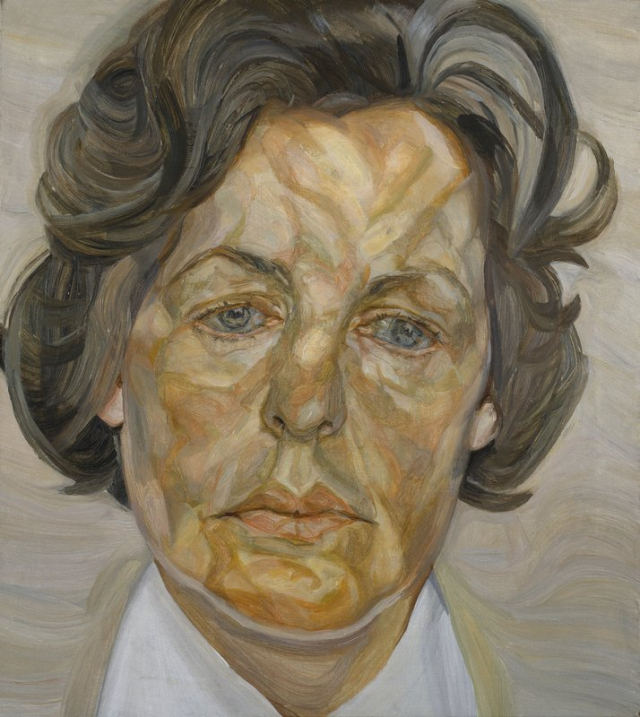
Lucian Freud, Woman in a white shirt Deborah Cavendish, Duchess of Devonshire. © Devonshire Collection. Reproduced by permission of Chatsworth Settlement Trustees.
What was your experience posing for him for the portrait that he later painted of you?
It was great. He was really good fun. He was very naughty. I was only 18 and not used to people like him. He had a studio with big floor-to-ceiling windows facing north. It was a horrible studio—quite filthy with his bed in one corner and a shared toilet down the stairs. All the meters—the electric, the water and the gas—were in the room with chains around them and locks on them. Sometimes the doorbell would ring and he’d look out of the window and he’d point, which meant that you had to go stand with your back to the wall between the two windows, because it was the gas man coming to cut off the gas.
Lucien always had five or six pounds in his pocket, which would have easily paid the bill; but he had a horse to back in the afternoon, so he wouldn’t do it. We’d sometimes stand there for half an hour until the man would eventually, furiously go away. That was a new world to me. It was fun—it was great fun. I’ve sat for other people and found it really hard to stay awake, but it was always exciting with Freud. (Duke of Devonshire)
Contemporary art.
You and your wife have also commissioned artists to make work for the Devonshire Collection, including Jacob van der Beugel’s incredible ceramic DNA wall installation that encompasses a complete room. How involved were you in the making of this piece?
We were very involved because he visually reproduced our family’s DNA on more than 600 ceramic panels. It started because of a second-floor room facing south that wasn’t a good place for showing work—certainly not works on paper and probably not even paintings, as it gets quite a bit of light. We had moved a lot of the vitrines out of rooms so our ceramics curator was increasing frustrated as there was no place to show the historic ceramics collection. We said okay, we’ll put it up here in this room; and she said half jokingly why don’t you turn the whole thing into a ceramic gallery. We interviewed five artists and went to their studios, but we didn’t go to Jacob’s. We chose him because he gave a very good account of what he was going to do. We said come back in three month’s time and tell us why you’re better than the rest—it’s a really clichéd question, but still it works—and he did it. (Duke of Devonshire)
There are three different contemporary ceramic installations at Chatsworth. The first one from 2007 is by Edmund de Waal, which is a series of white glazed pots that are placed in fireplaces and on mantelpieces. The second work was Jacob’s interpretation of our DNA, whicih took four years to complete. And the third one is a recent installation by Natacha Daintry. It’s a series of brightly colored pots that start out very small and are gradually scaled up by way of the Fibonacci sequence. (Duke of Devonshire)
I first became interested in ceramics when an ex-colleague at Sotheby’s, an auctioneer by the name of Henry Wyndham, gave me a small bowl, which was white on the outside and pale blue on the inside, by John Spearman. Henry left the price on the bottom, which was £65. I thought how can you get something so incredible for £65—I really need to find out more about it. That’s how it started. I bought more pieces by John Spearman and got to know some of the dealers and it grew from there. (Duke of Devonshire)
I like the sculptural aspect of ceramics. I basically only like the really plain stuff—not only, but mostly. I like the colored stuff by Pippin Drysdale very much, but it’s something different for to me. She’s become less affordable because she’s so successful. Edmund de Waal is even more successful, but luckily we found him a long time ago. I’d love to go back and get some more of his stuff. (Duke of Devonshire)
Your son, Lord Burlington, has also been active in adding contemporary works to the collection, including a remarkable collection of photographs of artists by Jorge Lewinski and the digital portrait of his wife, Lady Burlington, by Michael Craig-Martin. What do these acquisitions add to the collection?
I already mentioned the Michael Craig-Martin, which was commissioned after William and Laura’s wedding. It really updates the idea of portraiture in the collection. But the Lewinski acquisition was a bit of luck. When William was looking around for something to do a great friend of mine happened to know Lewinski. He only taught about five people at a time and suddenly had an open space. My friend knew that William liked taking photographs and told him about it. William went and loved it. He became a professional photographer for a few years and when Lewinski decided to sell his archive, which was mostly portraits of artists in their studios, we got it. The Tate was after it, but William spoke to Lewinski and said that we would look after it and always keep some pictures on view. Lewinski decided to sell his pictures to Chatsworth rather than the Tate, which would have taken good care of it but not necessarily kept pictures in sight. We always have a few on display, which are usually the artists that are part of the collection—like Lucien Freud, David Hockney and Michael Craig-Martin. (Duke of Devonshire)
Duke of Devonshire’s way to buy art.
Since you’re on the board at Sotheby’s and grew up in a family of collectors what do you tell people when they ask you how to go about starting a collection?
The first thing is you have to buy what you like. You shouldn’t care what other people think. And don’t go with other people to look at things. It’s much better to row your own … whatever you row. Follow your own route. And never ever try to buy things because you think they will accrue in value. That’s completely ridiculous. I know some people that are good at it and that’s fun, but it’s a different thing. If you are buying stuff for pleasure, you buy stuff. If you buy what you like and can just squeeze out an extra hundred dollars do it, because you always regret the things that you missed. Most people get a little bit wealthier as they get older, but the art gets more expensive and further and further out of reach. I always remember that with Milton Avery. I never bought a picture by Milton Avery because it was always too much, but I should have just said the hell with it and just bought it when I could. I never did and they’ve become too costly now.
It’s great if you can get to know the artists and talk with them; though it’s sometimes not very easy, because they are not always easy people. But you can talk to the dealers, who can be tremendously helpful. For me, it’s much more of a visceral thing than an intellectual one. I’m not ashamed of that; it’s just how it is. (Duke of Devonshire)
Do you buy from auctions and fairs?
We buy from auctions and fairs. We’re not buying all the time, but I do spend a fair bit of time looking at both art and design. I was just in Amsterdam for three days and will be in Copenhagen to look at ceramics in about three weeks’ time. I love going to fairs. I go regularly to Masterpiece and have attended TEFAF in both New York and Maastricht.
The design for the Sotheby’s exhibition is powerful in the way that is shows the breadth and grandeur of the collection, even though it’s only the tip pf the iceberg. How closely did you work with exhibition designer David Korins, who has designed several Broadway shows?
He came to stay for three days—just him, Amanda and me. We had him stay on the private side of the house. It was very interesting talking to him. He taught us a lot about Chatsworth. He looked at it with a fresh eye. He sat sometimes for hours. He got it. He’s obviously a very clever man. He did his design. That’s what he’s good at, not us. But we talked a lot, as I am now, and I think it was helpful to him. We played a reactive role, but supportive. (Duke of Devonshire)
Some of the most theatrical displays are those presenting the family jewels, including a glistening diamond tiara and the Devonshire Parure, which consists of seven exquisite pieces made from earlier pieces of jewelry in the family collection. Should these pieces be valued for their precious materials or their delightful design?
I think both; though I’m not sure what valued means at this point, perhaps appreciated. They’re odd. People don’t wear tiaras anymore, but they are lovely things. Amanda wore the tiara for our wedding; our daughter wore it; and our granddaughter has asked if she could wear it. (Duke of Devonshire)
The Mortlake Tapestries at Chatsworth were recently restored after being in the collection for centuries. What role do conservation of the art and restoration of the house and gardens play in the mission of the trust?
It’s pretty central. We have to look after things. I think we look after them better than they’ve been looked after before. We’re very aware of things like light damage, dust damage, dirt damage—all of those things—and we do our level best; but it’s a balance, as we want people to be able to enjoy the collection. In a way, the best manner of conservation is to lock everything up in a black box and leave it, as long as it doesn’t change temperature. But that’s no good because objects are made to be displayed, so you got to balance the two together. That said, the conservation is absolutely crucial, and there’s still a lot to be done. (Duke of Devonshire)
Since this was a costly show to produce, but not a selling exhibition, what’s the benefit to Sotheby’s and the Chatsworth House Trust?
Sotheby’s, which is 275 years old, has redone their rooms in a spectacular way. I think they wanted something to demonstrate to clients or potential clients that collecting is a lot of fun. Collecting is quirky; it’s unusual; and it can turn shopping into something that’s miraculous. They found a collection that has old and new stuff, which fits Sotheby’s quite well. (Duke of Devonshire)
From our point of view, we wanted to make people in the United States more aware of Chatsworth. We want to see our they react to it, gain some new insights from the experience and just see what happens. It was a lot of work, but we’ve sent many exhibitions to America in the past. My father sent a big exhibition in 2002 with seven or eight venues that was completely non-commercial. He said once—just before he died—that he did it because he wanted to thank the Americans for what they did in the war, which is something that people of my generation still feel very strongly about. (Duke of Devonshire)
November 7, 2019
